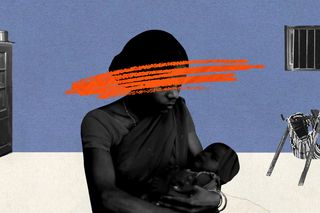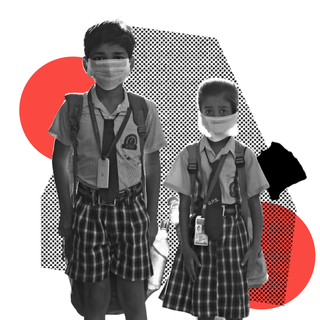
How Social and Medical Biases Keep Low‑Income Indian Women From Getting Postpartum Mental Health Care
My study showed that a staggering 34% of mothers from low-income groups had postpartum depression, and desperately needed psychiatric help.

“I want to die,” said Sama*, a mother of a two-day-old baby.
After delivering a chubby baby boy, Sama spent the next few days in a blurry, sleepless daze. As her doctors, we thought this would eventually fade, but Sama’s mother brought her back to the hospital in three weeks. She’d had spells of unconsciousness due to lack of sleep. Upon evaluation, she was diagnosed with postpartum depression (PPD).
For Sama, the road to recovery wasn’t easy because of a delayed diagnosis, and constantly being told that what she felt was absolutely “normal” as a new mother. Her in-laws saw her distress and advised her to feel grateful for at least having a boy. Sama was lost. She didn’t know what to do––she was exhausted all the time and just wanted her suffering to end.
As was the case with Sama, PPD is a depressive disorder that is often dismissed as a normal consequence of childbirth and motherhood.
As a society, when we talk about PPD, we talk about psychologists, psychiatrists, OBGYNs in private practice, expensive medications and therapy sessions, and most importantly, an understanding of what is happening to an upper class and caste mother with PPD. What we miss out on is women from the lower and middle socioeconomic strata who make up the largest base of women’s medical health in India. Women like Sama from low-income groups suffer from PPD without even knowing what is wrong with them and grapple with it completely suspended from support.
What research has to say
There seems to exist a bias in medicine that is influenced by socioeconomic status. Healthcare in India assumes that interdisciplinary care is extended to everyone irrespective of status. It assumes that all women have the vocabulary to recognize or explain what they are going through, so no effort is made to communicate with them. A lot of information about PPD is in English, a language not widely spoken by mothers from low-income groups.
Frustrated by this chasm that appeared to be invisible to everyone, I decided to study the Indian story of postpartum depression at a tertiary care charitable hospital in Navi Mumbai, Maharashtra. I aimed to see what was happening with “every woman”, and not just those who could afford multidisciplinary healthcare.
I looked at 200 women from economic lower and lower-middle sections of society – home-makers, female laborers or wives of daily-wage workers, female household staff from marginalized backgrounds, and women in low-paying clerical positions. The age demographic was between 18 to 40 years. 10% of these women were illiterate, while 43.5% were educated up to standard 6 in school.
Related on The Swaddle:
Postpartum Depression Can Hit Any Time Within 3 Years of Childbirth: Study
What I learned from my study was staggering. My results showed that 34% of these women had suffered from PPD at some given point in time, in the ward that I was responsible for. Their EPDS scores were higher than 12 indicating the presence of PPD and the need for further evaluation. 20% of these women had a score that indicated the possibility of depression and the need for counseling.
We, as doctors, were missing them all. Due to the lack of awareness of PPD within these women, they didn’t even know that something was medically wrong with them and that this feeling was not their “fault.” More importantly, they didn’t know help was available to them.
As a gynecologist, I couldn’t believe doctors had overlooked every single woman who is going through this by just screening them out by bias. We were assuming that women from low-income groups in urban and semi-urban India would not suffer from mental illnesses like PPD because they may not have the emotional capacity to understand their feelings.
We also found that women who were home-makers were significantly predisposed to PPD, compared to women who were working during their pregnancy. Women who had financial problems also had a higher incidence of PPD.
Social biases also inform obstacles in PPD diagnosis. Through misinformation and cinema, Indian society has rooted the idea that a woman is supposed to unconditionally love her child, no matter what. If she feels anything less than tumultuous joy, she’s considered a “bad mother”. Relatives of patients with PPD have shunned them, throwing the mother into a deeper depressive hole. But awareness can turn this around.
My patient Malti* had delivered a preterm baby who spent 28 days in the newborn intensive care unit (NICU). She waited to feed him every two hours while her husband, a laborer, went to work. Her screening test showed she had PPD. Once we started her on antidepressants and more importantly, included her husband in her recovery, he spent every night with her outside the NICU looking at their baby. He understood that she needed his help and his support.
A new mother, Radha*, refused to feed her newborn regularly. She would lie awake next to the baby while the hungry infant cried. The baby developed jaundice and was put on phototherapy. She refused to answer why she wasn’t feeding her baby. When I administered the PPD screening test, it was clear as day that she was suffering from postpartum depression. It was only after her treatment that she said, “I didn’t feel anything for my baby – not love, not hate. I looked at my baby and felt helpless. How could it be possible that I couldn’t love my own baby?”
Related on The Swaddle:
The Pandemic Has Caused a Postpartum Depression Crisis in India
PPD during Covid19
Statistically, the global prevalence of PPD is 17.7%, while in developed countries it ranges between 10 to 15%. In most South Asian countries, PPD is prevalent up to 15%, according to a study. The same study shows that this number has gone up in the pandemic to about 30%. The pandemic also has brought in more anxiety, as 72% of new mothers said they were worried about themselves and their newborns contracting Covid19. 65% of them were feeling significantly more anxious about their postpartum period.
Most small maternity hospitals and nursing homes have been shut during this pandemic and some district hospitals have been converted into Covid19 centers, stranding antenatally registered mothers from lower socioeconomic groups. During the pandemic’s worst days, laboring mothers in Indian charitable hospitals went into the delivery room alone. No loved ones were allowed in during labor and delivery.
This places mothers from non-upper castes and classes in a situation of greater psychological vulnerability and heightens the risk of postpartum depression and disrupted mother-infant bonding. Rising unemployment rates, loss of job security, and rising financial crises especially in families that have lower rates of bonding, of familial and partner support, are major stressors predisposing to PPD.
Corrective measures
The most common and the gold standard of screening for PPD across the world is the Edinburgh Postnatal Depression Scale (EPDS), which contains 10 multiple choice questions about how a new mother has been feeling in the last seven days. It includes easy to answer multiple-choice questions like:
“Are you blaming yourself unnecessarily when things go wrong?”
“Are you anxious or worried for no good reason?”
“Do you have trouble sleeping?”
“Any thoughts of self-harm?”
Unfortunately, India does not have any PPD screenings like the EPDS in its government healthcare guidelines. Therapy sessions or psychiatric medications for new mothers are also not part of public health or government schemes. A lot of doctors are not even aware of screening scales or the need for them.
And herein lies the problem. Because women’s health doesn’t get the research it deserves, women themselves perceive pain from a “pain threshold” and “should just bear it” perspective. If we expect adherence to patriarchal behavior from mothers, how can they look inwards to assess if they need help?
No one is creating an open and inclusive place for mothers from marginalized classes and castes to open up about what they’re going through post-childbirth. We may be talking around them, but we are not talking to them. It’s almost like we rule these women out because we assume they have “bigger” problems to deal with like poverty and survival, not realizing that public apathy towards their health is an intrinsic part of their “bigger” obstacles.
Healthcare needs to be more inclusive of mental health across primary, secondary, and tertiary care centers in India. Mental health checks becoming instituted in antenatal care across both rural and urban setups by screening women for postpartum depression, antenatal anxiety, and more by including even ASHA workers in the education and screening process can improve our situation drastically. Including therapy sessions and antidepressants in government schemes can also help millions of new mothers in treating this debilitating but very curable condition.
It’s high time all women have access to quality healthcare and not just those who can afford private wards in city hospitals.
*Names have been changed to protect privacy
Note: This article has been written based on original research accepted for publication in the Journal of South Asian Federation of Obstetrics and Gynaecology.
Dr. Esha Chainani is an Obstetrician and Gynaecologist practicing in Mumbai. She advocates for the availability of quality healthcare for all women.
Related


Women of Color Are Less Likely to Get an HPV Diagnosis, Shows Research
